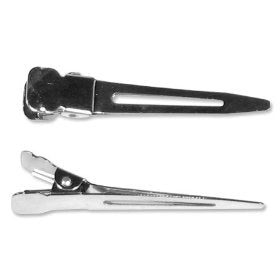Twisting & Re-Twisting Dreadlocks
Twisting and Re-Twisting are pretty much the same thing when talking about dreadlocks. Often twisting refers to when you first start your dreadlocks while re-twisting is maintenance done to tighten your dreads. In both cases the main idea is to put a locking cream of some type on the hair or dreads, twist it and allow it to dry twisted. You simply spin the dreadlock until it us under enough tension to compress it and make it feel tight, while at the same time applying some dread cream directly to the dread, working it in as you twist it around and around, always to the right or "clockwise".
If you are re-twisting longer dreadlocks that have already started to mature at the body and tip of the dread you can usually concentrate your twisting on the first 3" of each dread near the roots. After the dread is twisted just pin, clip, or attach the dread in some manner to hold it in this twisted position. Clips are very popular, shown below.
After all dreads are twisted and secured the dreadlocks should be dried with a hair dryer. Take care not to over heat the hair as it will do more harm than good. Let it dry completely and sit for at least 3 hours if possible. Then you can release or un-clip the dreads. The quality of the dreadlock cream used, your activity level and how rough you are with the dreads will determine how long the twists will stay tight. Different clips work better depending on the length of the dreadlocks but most will do fine as long as the dreads are held so they can't un-twist and as long as they are not damaging to the hair/dreads.
Re-Twisting with Rubberbands
If you don't have access to clips but rubber bands are handy you can use the following method, it's just another way to secure the hair, the cream and tension are used in the same way. The idea is simple. If were to twist a section of hair, put a rubber band on it and then release it would quickly unravel. However, if you twist several dreadlocks, maybe eight or so, independently, twisting them one at a time holding the ones that have already been twisted and taking care that they don't unravel while you work on twisting additional ones, you can rubberband the whole lot together and they will prevent each other from un-twisting. (Man that was a long sentence.) This is often quicker than using clips and it's much easier to sleep on than clips if you decide to let them stay twisted all night. The only down side to using rubber bands on groups of dread is that you have to take special care to ensure that all of the dreadlocks dry thoroughly. It will be quite a mass of hair so you'll probably need to use a hair dryer to get the inner dreads completely dry. If you find that some are taking too long to dry use smaller groups with few dreads.



